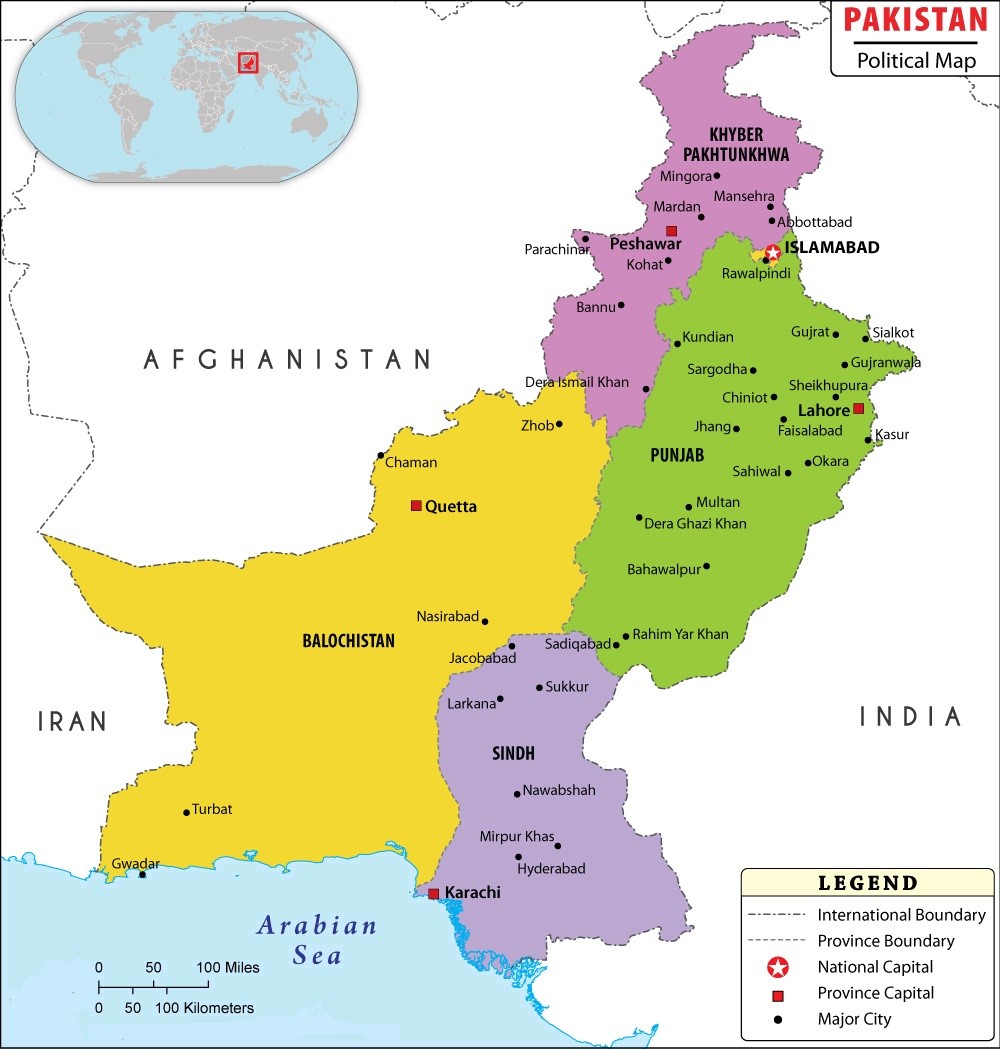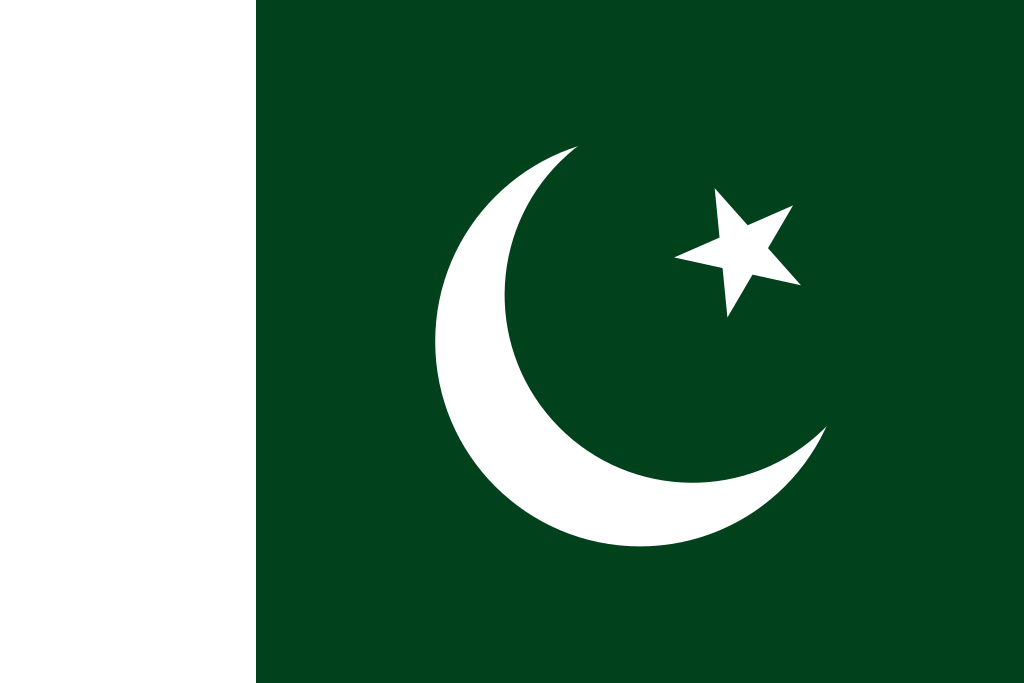Fact Sheet


GENERAL
|
Official Name |
Islamic Republic of Pakistan |
|
Capital |
Islamabad |
|
Area |
796,095 sq. km [India: 3.3 million sq. km] |
|
Weather (in °C) |
Mostly hot, dry desert, continental ; temperate in northwest; arctic in north Average temperature in Islamabad: January: 2 degrees Celsius ; June: 40 degrees Celsius |
|
Population |
212,220,000 (2018, World Bank); 207,774,520 (Census of Pakistan, 2017) |
|
Forest Cover (% of total area) |
4.9% (2018, World Bank) |
|
CO2 Emissions |
196,180 kt (2018) |
|
Age profile |
0-14 years: 36.01% (male 42,923,925/female 41,149,694) 15-24 years: 19.3% (male 23,119,205/female 21,952,976) 25-54 years: 34.7% (male 41,589,381/female 39,442,046) 55-64 years: 5.55% (male 6,526,656/female 6,423,993) 65 years and over: 4.44% (male 4,802,165/female 5,570,595) (2020 est. CIA World Factbook) |
|
Life Expectancy |
69.2 years Male: 67.2 years Female:71.3 years (2020 est.CIA World Factbook) |
|
Languages (with % age |
Punjabi 48%, Sindhi 12%, Saraiki (a Punjabi variant) 10%, Pashto/Pashtu 8%, Urdu (official) 8%, Balochi 3%, Hindko 2%, Brahui 1%, English (official; lingua franca of Pakistani elite and most government ministries), Burushaski, and other 8%. |
|
Ethnic Groups |
Punjabi 44.7%, Pashtun (Pathan) 15.4%, Sindhi 14.1%, Saraiki 8.4%, Muhajirs 7.6%, Balochi 3.6%, other 6.3% |
|
Main Religions |
Muslim (official) 96.4% (Sunni 85-90%, Shia 10-15%), other (includes Christian and Hindu) 3.6% |
|
Internet Penetration |
31,338,715 users 15.5% of population (2018, World Bank) |
|
Mobile Phones |
153,986,607 Subscription per 100: 72 (2018, World Bank) |
|
Urbanization |
37.2% of total population (2020 est. CIA World Factbook) |
ECONOMIC
|
Currency |
PKR 154 (2 June 2021) (Source: State Bank of Pakistan) |
GDP |
US$ 248.128 Billion (2020, Pakistan Bureau of Statistics) |
|
GDP Growth Rate |
3.94% (2020-21) (Source: Projected by National Accounts Committee) |
|
Major Sectors (% of GDP) |
Agriculture 18.5% (FY2018-19) Industry 20.3% (FY2018-19) Services 61.2% (FY2018-19) (Source: Ministry of Finance, Govt. of Pakistan) |
|
Unemployment Rate (%) |
5.80% in 2017-18 Rural 5.00% in 2017-18 Urban 7.20% in 2017-18 (Source: Ministry of Finance, Govt. of Pakistan) |
|
Inflation (%) |
11.2% (FY 2020) (Source: Pakistan Ministry of Finance) |
|
GDP Per Capita |
US$ 1260 (2020) (Source: Bureau of Statistics) |
|
Total Trade (Goods & services) |
US$ 66 billion |
|
Exports (Goods & Services) |
US$ 22.53 billion (FY 2020) (Source: State Bank of Pakistan) |
|
Imports (Goods & Services) |
US$ 43.6 billion (FY 2020) (Source: State Bank of Pakistan) |
|
Balance of Trade |
US$ -21 billion (FY 2020) (Source: State Bank of Pakistan) |
|
Major Trading Partners |
(i) |
China |
Exports US$1.86 billion Imports US$ 12.4 billion |
|
|
(ii) |
USA |
Exports US$ 4.14 billion Imports US$ 2.58 billion |
|
|
(iii) |
UK |
Exports US$ 1.72 billion Imports US$ 0.611 billion |
|
|
(iv) |
UAE |
Exports US$ 1.69 billion Imports US$ 4.179 billion |
|
|
(v) |
Saudi Arabia |
Exports US$ 0.432 billion Imports US$ 1.8 billion |
|
|
(vi) |
Spain |
Exports US$ 0.794 billion Imports US$ 0.173 billion |
|
|
(vii) |
South Korea |
Exports US$ 0.183 billion Imports US$ 1.06 billion |
|
|
(viii) |
Germany |
Exports US$ 1.3 billion Imports US$ 0.853 billion |
|
|
(viii) |
France |
Exports US$ 0.396 billion Imports US$ 0.356 billion |
|
|
(Source: State Bank of Pakistan) |
||
POLITICAL
|
Political Structure |
Pakistan is a democratic parliamentary federal republic with Islam as the state religion. The first constitution was adopted in 1956 (suspended by Gen Ayub Khan in 1958, who replaced it with the second constitution in 1962). A comprehensive constitution was adopted in 1973 (suspended by Zia-ul-Haq in 1977 but reinstated in 1985). |
|
The Pakistani military establishment has played an influential role in mainstream politics throughout Pakistan’s political history. The periods 1958-1971, 1977-1988 and 1999-2008 saw military coups that resulted in the imposition of martial law and military commanders who governed as de facto presidents. The first successful democratic transition occurred in the general elections of 2013. The main political parties presently are the Pakistan Muslim League (Nawaz), Pakistan Tehreek-e-Insaf (incumbent government led by Prime Minister Imran Khan) and Pakistan Peoples’ Party (PPP). |
|
The President, elected by an Electoral College is the ceremonial head of the state and is the civilian commander-in-chief of the Pakistan Armed Forces. The 18th amendment passed in 2010 stripped the presidency of its major powers and thereby its authority. Since then Pakistan has been shifted from a semi-presidential system to a purely parliamentary government. The Prime Minister is the leader of the majority rule party or a coalition in the National Assembly (Lower House). The Prime Minister serves as the head of the government assisted by his cabinet ministers and special advisors. |
|
The bicameral legislature (Majles-e-Shura) comprises a 100-member Senate (upper house) (6-year term) and a 342-member National Assembly (lower house) (5-year term). 272 Members of the National Assembly are directly elected in single-seat constituencies by simple majority vote and 70 members-60 women and 10 non-Muslims while Senate has representatives from Provincial Assemblies, reservations for women, Ulema/technocrats etc. |
|
The judiciary of Pakistan is a hierarchical system with two classes of courts: the superior (or higher) judiciary and the subordinate (or lower) judiciary. The superior judiciary is composed of the Supreme Court of Pakistan, the Federal Shariat Court and five High Courts, with the Supreme Court at the apex. |
|
Pakistan is subdivided into 4 provinces and 1 Islamabad Capital Territory. Each province has a provincial assembly, a directly elected legislature elected for five-year terms. |
|
Head of State (President) |
Dr. Arif Alvi (since 9 September 2018) |
|
Head of Government |
Imran Khan (since 18 August 2018)
|
|
Minister of Foreign Affairs |
Shah Mehmood Qureshi (since 20 August 2018) |
|
Political Issues |
Prime Minister Imran Khan led-Pakistan Tehreek-e-Insaf (PTI) government enjoys majority (with support of smaller coalition partners, 176/342 seats) in the National Assembly and runs two (out of four) provincial governments in Pakistan viz. Punjab & Khyber Pakhtunkhwa and is part of ruling coalition in third province Balochistan. Pakistan Muslim League (Nawaz) [PML-N] and Pakistan Peoples’ Party [PPP] are the two main opposition parties. PML (N) is the main opposition party in the National Assembly. The opposition parties enjoy a thin majority in the Senate. |
|
BILATERAL |
|
|
Bilateral Trade |
US$ 279.92 million (FY 2020) |
|
Indian Exports |
US$ 277.62 million (FY 2020) |
|
Imports into India |
US$ 2.30 million (FY 2020) |
|
Major Items of Export and Import |
Exports to Pakistan: Cotton, organic chemicals, machinery, food products including prepared animal fodder, vegetables, plastic articles, man-made filament, coffee, tea and spices, dyes, oil seeds and olea, etc |
|
|
Imports from Pakistan: copper and copper articles, fruits and nuts, cotton, salt, sulphur and earths and stones, organic chemicals, mineral fuels, rubber plastic products, wool, etc. |
|
Indian Investments in the Country |
NIL |
|
Country’s Investments in India |
NIL |
|
Indian Origin/ PRs/ |
As per information available with Mission, more than 200 Indian students are undergoing various courses in Pakistan. |
|
Indian Organisations
|
NIL |
|
|
 Sitemap
Sitemap








